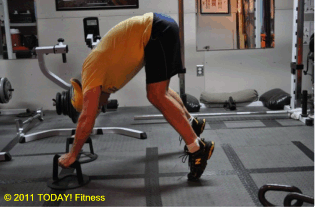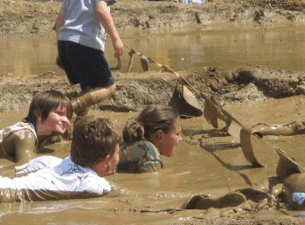|
Heart Rate
Training |
|
I'm
a big proponent of heart rate monitors and typically
try to use one at the beginning of my outdoor cardio
season... mostly to understand how my body feels in
the appropriate training zones. The following
article is one that I found that was very
informative on the topic of heart rate training from
an elite athlete that really knows his stuff...
Working Your Heart - The secret of training smart
by Mark
Allen - 6 Time Ironman World Champion
During
my 15 years of racing in the sport of triathlons I
searched for those few golden tools that would allow
me to maximize my training time and come up with the
race results I envisioned. At the top of that list
was heart rate training. It was and still is the
single most potent tool an endurance athlete can use
to set the intensity levels of workouts in a way
that will allow for long-term athletic performance.
Yes, there are other options like lactate testing,
power output and pace, but all of these have certain
shortcomings that make them less universally
applicable than heart rate.
Endurance is THE most important piece of a
triathleteís fitness. Why is it tough to develop?
Simply put, it is challenging because it usually
means an athlete will have to slow things down from
their normal group training pace to effectively
develop their aerobic engine and being guided by
what is going on with your heart rate rather than
your will to the champion of the daily training
sessions with your training partners! It means
swimming, cycling and running with the ego checked
at the door. But for those patient enough to do just
that, once the aerobic engine is built the speedwork
will have a profound positive effect their fitness
and allow for a longer-lasting improvement in
performance than for those who blast away from the
first day of training each year.
What is the solution to maximizing your endurance
engine? Itís called a heart rate monitor.
Whether your goal is to win a race or just live a
long healthy life, using a heart rate monitor is the
single most valuable tool you can have in your
training equipment arsenal. And using one in the way
I am going to describe will not only help you shed
those last few pounds, but will enable you to do it
without either killing yourself in training or
starving yourself at the dinner table.
When I entered the sport of triathlon in the early
1980ís, my mentality was to go as hard as I could at
some point in every single workout I did. And to
gauge how fast that might have to be, I looked at
how fast the best triathletes were running at the
end of the short distance races. Guys like Dave
Scott, Scott Tinley and Scott Molina were able to
hold close to 5 minute miles for their 10ks after
swimming and biking!
So thatís what I did. Every run, even the slow ones,
for at least one mile, I would try to get close to 5
minute pace. And it workedÖsort of. I had some good
races the first year or two, but I also suffered
from minor injuries and was always feeling one run
away from being too burned out to want to continue
with my training.
Then came the heart rate monitor. A man named Phil
Maffetone, who had done a lot of research with the
monitors, contacted me. He had me try one out
according to a very specific protocol. Phil said
that I was doing too much anaerobic training, too
much speed work, too many high end/high heart rate
sessions. I was forcing my body into a chemistry
that only burns carbohydrates for fuel by elevating
my heart rate so high each time I went out and ran.
So he told me to go to the track, strap on the heart
rate monitor, and keep my heart rate below 155 beats
per minute. Maffetone told me that below this number
that my body would be able to take in enough oxygen
to burn fat as the main source of fuel for my muscle
to move. I was going to develop my aerobic/fat
burning system. What I discovered was a shock.
To keep my heart rate below 155 beats/minute, I had
to slow my pace down to an 8:15 mile. Thatís three
minutes/mile SLOWER than I had been trying to hit in
every single workout I did! My body just couldnít
utilize fat for fuel.
So, for the next four months, I did exclusively
aerobic training keeping my heart rate at or below
my maximum aerobic heart rate, using the monitor
every single workout. And at the end of that period,
my pace at the same heart rate of 155 beats/minute
had improved by over a minute. And after nearly a
year of doing mostly aerobic training, which by the
way was much more comfortable and less taxing than
the anaerobic style that I was used to, my pace at
155 beats/minute had improved to a blistering 5:20
mile.
That means that I was now able to burn fat for fuel
efficiently enough to hold a pace that a year before
was redlining my effort at a maximum heart rate of
about 190. I had become an aerobic machine! On top
of the speed benefit at lower heart rates, I was no
longer feeling like I was ready for an injury the
next run I went on, and I was feeling fresh after my
workouts instead of being totally wasted from them.
So letís figure out what heart rate will give you
this kind of benefit and improvement. There is a
formula that will determine your Maximum Aerobic
Heart Rate, which is the maximum heart rate you can
go and still burn fat as the main source of energy
in your muscles. It is the heart rate that will
enable you to recover day to day from your training.
Itís the maximum heart rate that will help you burn
those last few pounds of fat. It is the heart that
will build the size of your internal engine so that
you have more power to give when you do want to
maximize your heart rate in a race situation.
Here is the formula:
-
Take
180
-
Subtract your age
-
Take
this number and correct it by the following:
-
If you
do not workout, subtract another 5 beats.
-
If you
workout only 1-2 days a week, only subtract 2 or 3
beats.
-
If you
workout 3-4 times a week keep the number where it
is.
-
If you
workout 5-6 times a week keep the number where it
is.
-
If you
workout 7 or more times a week and have done so
for over a year, add 5 beats to the number.
-
If you
are over about 55 years old or younger than about
25 years old, add another 5 beats to whatever
number you now have.
-
If you
are about 60 years old or older OR if you are
about 20 years old or younger, add an additional 5
beats to the corrected number you now have.
You now
have your maximum aerobic heart rate, which again is
the maximum heart rate that you can workout at and
still burn mostly fat for fuel. Now go out and do
ALL of your cardiovascular training at or below this
heart rate and see how your pace improves. After
just a few weeks you should start to see a dramatic
improvement in the speed you can go at these lower
heart rates.
Over time, however, you will get the maximum benefit
possible from doing just aerobic training. At that
point, after several months of seeing your pace get
faster at your maximum aerobic heart rate, you will
begin to slow down. This is the sign that if you
want to continue to improve on your speed, it is
time to go back to the high end interval anaerobic
training one or two days/week. So, you will have to
go back to the ďNO Pain, NO GainĒ credo once again.
But this time your body will be able to handle it.
Keep at the intervals and you will see your pace
improve once again for a period. But just like the
aerobic training, there is a limit to the benefit
you will receive from anaerobic/carbohydrate
training. At that point, you will see your speed
start to slow down again. And that is the signal
that it is time to switch back to a strict diet of
aerobic/fat burning training.
At the point of the year you are in right now,
probably most of you are ready for this phase of
speed work. Keep your interval sessions to around
15-30 minutes of hard high heart rate effort total.
This means that if you are going to the track to do
intervals do about 5k worth of speed during the
entire workout. Less than that and the physiological
effect is not as great. More than that and you just
canít maintain a high enough effort during the
workout to maximize our benefit. You want to push
your intervals, making each one a higher level of
intensity and effort than the previous one. If you
reach a point where you cannot maintain your form
any longer, back off the effort or even call it a
day. That is all your body has to give.
|
|

|
|
|
Bodyweight Exercise of the Month! |
|
Piked Press

Summary:
The piked press is a typical
example of a bodyweight shoulder exercise that mimics a
military (overhead) press. Handstand pushups are an
extremely difficult exercise to start with and master.
The more you bend at the waist from the handstand, the more
weight that you take away from the pressing movement.
The piked press is a very good exercise to start with for the
pressing motions and is actually a lot tougher than it looks.
The use of pushup bars allow for your head to drop further
than your hands providing a better range of motion.
Target: shoulders and
arms (deltoids, triceps brachii)
Count:
2 count
Description: From a
standing position, bend at the waist until you can place your
hands on the floor shoulder width apart, roughly 2-3 feet in
front of your feet. Keeping your head between your
hands, come up on your toes so that you can place most of your
weight on your hands. While you are pressing, you will
want to touch the "top" of your head to the ground rather than
your forehead (allowing for nuetral neck/spine alignment).
Repeat for maximum repetitions.
|
|
Muddy Running |
|
I am admittedly not a runner.
Even before I blew out my knee wrestling, I just
never really got into the whole running thing. However,
I LOVE these mud runs! I did one 5K mud run last year
and will finish up with four this year.
They are a combination of exercise, mixed in with fun, and a
bit of crazy
J

Mud runs are springing up all over
the place. They have been getting a lot of attention and
are becoming a favorite event for charity fundraisers. What's a mud run you ask?
Think of your standard 5K/10K run... take it off road onto
dirt paths... throw in a dozen or so obstacles along the
way... and end it with a nice long belly crawl through a
murky, messy, mud pit!
Personally, I find these to be
easier than road running. It's definately got an
interval training feel to it. You run for a little while
down a path... jump over a wall... run a little more... crawl
through a tunnel... run some more... climb some cargo nets...
etc...
Some mud runs are local like the
Delaware Mud Run that we did last weekend (which raised
$350,000 for cancer research). Others are a nationwide
series that travel from town to town throughout the season.
Among these are the
Merrill Down and Dirty Mud Run Series,
The
Warrior Dash,
The Spartan Race, and the big daddy of them all
The
Tough Mudder. New races are popping up all the time.
Depending on the mud run, there
are often options for the kids to join in the fun. My
daughter Rachel did the Philly Mud Run (Merrill) with me the
past 2 years since they have a 1 mile kids version for her age
that ends through the same mud pit. These are memories
that she'll hopefully remember for quite some time
J
They also had a 100 yard dash for the very little kids that
ended through the pit... too cute!
The obstacles are the fun part to
me. The mud pit is pretty standard, but they often throw
some interesting ones in there. You typically see
various low walls, tunnels, high rope walls, balance beams,
cargo nets, etc... but I've also had monkey bars, stream
running, wading through a waist high lake, jumping over a fire
and a face first slide into a pit of muddy water and ice. Some
of the Facebook groups for various runs even take ideas from
the member community... you should see some of the
contraptions that they come up with for the Tough Mudder!
From my experience, there are a
few things that make for a good mud run. Logistics are
key. Parking, shuttles, registration, and overall event
entertainment are all things outside of the run that are
important. I've spent an hour or so just getting to the
parking and starting line in the past. Some events have
bands, DJs, radio stations. Some end with a barbeque...
others have concession stands complete with beer for the after
mud run festivities.
One of the biggest challenges is
how they run the "waves" of people that they let onto the
course at a time. If not run properly, you could be
waiting anywhere from 10-30 minutes just to jump over a wall
or something. Between the spacing of the waves, and the
size of the obstacle, this is something that is typically the
focus of "improvement for next year" by the run coordinators.
Figured I'd give you the heads up ahead of time so that you
don't get upset about not breaking any land speed records ; )
I have my last mud run of the
season tomorrow with my brother Mike. It's a Merrill
Down and Dirty 5K at Pelham Bay Park, New York (Bronx).
Supposed to be good weather, but if it rains, that just means
more mud! J
 |
|
It's Go Time!
|
|
Scary! It's October already!
Now you can take a break, stop working out, and eat what you
want for a few months, right? I DON'T THINK SO!
Now's the time to turn it up and make some impact on your body
before next summer! If you think about it, there are way
too many vacations, barbeques, and related gatherings to be
good all summer... so now is the time to buckle down and make
some impact before the time of little clothing comes around
again! Whether it be toning and trimming, or muscle
building and strength, set some realistic, measurable goals...
write them down... and GO GET IT!
The winter is when I switch things
up a little, at least for my cardio workouts. My bike
gets put up on the wall in the garage and I break out my Plyo
X and INSANITY DVDs...sometimes even saying hello to my
elliptical. Throughout the cold and gloomy winter, I
know that I for one have to keep it interesting for
motivation. By switching things up between DVD workouts,
elliptical training, maybe a sandbag interval complex, it
keeps things fresh and gives me a little kick here and there.
Everybody's different, so find out what works for you and go
after it! Let's make a change for the better during
these cold months!
For
prior issues of this eNewsletter, to subscribe, or
unsubscribe, please visit the following
link -->
todayfitness.net/news.
Exceed Your
Potential!
Pete
Mazzeo, CPT
pmazzeo@todayfitness.net
"Opportunity does not knock, it presents itself
when you beat
down the door." -Kyle
Chandler
youtube of the month -->
Box Jump Progressions
Very
good tips about the popular "box jump" exercise by Speed
Guru Lee Taft.
|
|